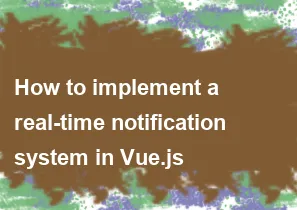How to implement a real-time notification system in Vue.js

Implementing a real-time notification system in Vue.js involves a few key steps. You'll typically need a backend service to handle notifications and push them to your Vue.js application. Here's a basic outline of how you could set it up:
Backend Service: You need a backend service to manage notifications and push them to clients in real-time. This could be built using technologies like Node.js with Express, Django, Flask, or any other backend framework. For real-time functionality, you'll likely want to use WebSockets or a similar technology.
WebSocket Server: Set up a WebSocket server in your backend to handle real-time communication with the client. Socket.io is a popular library for this purpose, as it provides a simple API for working with WebSockets.
Client-Side Setup: In your Vue.js application, you'll need to establish a WebSocket connection with the server to receive notifications in real-time.
Here's a simplified example of how you might set up the client-side part in Vue.js using Socket.io:
html<template>
<div>
<ul>
<li v-for="notification in notifications" :key="notification.id">
{{ notification.message }}
</li>
</ul>
</div>
</template>
<script>
import io from 'socket.io-client';
export default {
data() {
return {
notifications: []
};
},
created() {
// Connect to the WebSocket server
this.socket = io('http://localhost:3000');
// Listen for incoming notifications
this.socket.on('notification', (notification) => {
this.notifications.push(notification);
});
},
beforeDestroy() {
// Disconnect from the WebSocket server when the component is destroyed
if (this.socket) {
this.socket.disconnect();
}
}
};
</script>
In this example:
- We import the Socket.io client library.
- In the
createdhook, we establish a connection to the WebSocket server (http://localhost:3000in this case) and listen for incoming notifications. - When a notification is received, it's added to the
notificationsarray, which is then rendered in the template. - We disconnect from the WebSocket server when the component is destroyed to prevent memory leaks.
On the server-side, you would emit notifications whenever something happens that warrants sending a notification to the client. For example:
javascript// Server-side code using Socket.io
const io = require('socket.io')(3000);
io.on('connection', (socket) => {
console.log('Client connected');
// Simulate sending notifications
setInterval(() => {
socket.emit('notification', { id: Date.now(), message: 'New notification!' });
}, 5000);
socket.on('disconnect', () => {
console.log('Client disconnected');
});
});
In this example, the server emits a notification to all connected clients every 5 seconds. In a real-world application, you would emit notifications based on specific events or triggers in your backend logic.
This is a basic example to get you started. Depending on your specific requirements, you may need to add more features such as authentication, handling different types of notifications, or storing notifications in a database.
-
Popular Post
- How to optimize for Google's About This Result feature for local businesses
- How to implement multi-language support in an Express.js application
- How to handle and optimize for changes in mobile search behavior
- How to handle CORS in a Node.js application
- How to use Vue.js with a UI framework (e.g., Vuetify, Element UI)
- How to configure Laravel Telescope for monitoring and profiling API requests
- How to create a command-line tool using the Commander.js library in Node.js
- How to implement code splitting in a React.js application
- How to use the AWS SDK for Node.js to interact with various AWS services
- How to use the Node.js Stream API for efficient data processing
- How to implement a cookie parser middleware in Node.js
- How to implement WebSockets for real-time communication in React
-
Latest Post
- How to implement a dynamic form with dynamic field styling based on user input in Next.js
- How to create a custom hook for handling user interactions with the browser's device motion in Next.js
- How to create a custom hook for handling user interactions with the browser's battery status in Next.js
- How to implement a dynamic form with dynamic field visibility based on user input in Next.js
- How to implement a dynamic form with real-time collaboration features in Next.js
- How to create a custom hook for handling user interactions with the browser's media devices in Next.js
- How to use the useSWRInfinite hook for paginating data with a custom loading indicator in Next.js
- How to create a custom hook for handling user interactions with the browser's network status in Next.js
- How to create a custom hook for handling user interactions with the browser's location in Next.js
- How to implement a dynamic form with multi-language support in Next.js
- How to create a custom hook for handling user interactions with the browser's ambient light sensor in Next.js
- How to use the useHover hook for creating interactive image zoom effects in Next.js